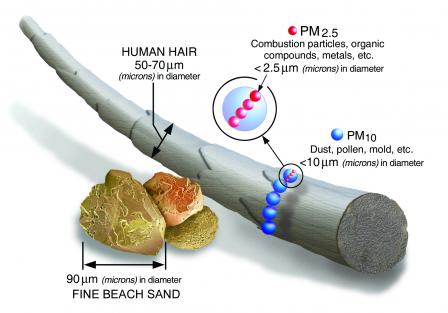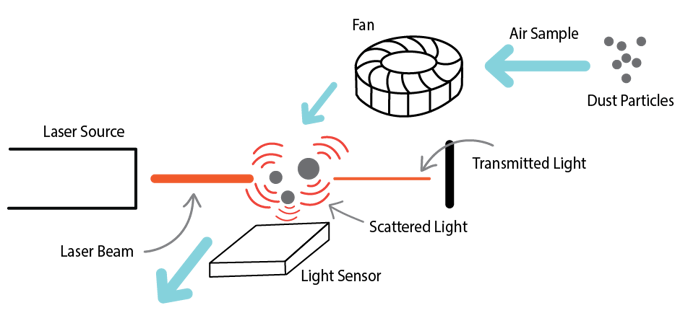The PocketLab Air PM sensor uses the principle of laser scattering to count the particles in the air.
Three Sizes of Particulate Matter
The PocketLab Air measures three sizes of particulate matter: PM 1.0, PM 2.5, and PM 10. Using the settings menu you can select which size particles are displayed. PM 1.0 is the smallest sized particulates, PM 2.5 are mid sized, and PM 10 are the largest.

Background Information on Particulate Matter
Particulate matter consists of small particles suspended in the atmosphere. Dust, pollen, sea salt, soil particles, mold, soot, smoke, and other fine substances create a mixture of particulate matter that we inhale with every breath. According to the EPA, particulate matter greater than 10 micrometers is generally filtered away in our nose and throat. Particulates less than 10 micrometers can often pass into the lungs. The smaller the particle size, the farther it can move into the cardiovascular system and cause serious health concerns.
Inhalable coarse particles (PM 10)
Diameter: 2.5 micrometers - 10 micrometers
Emission sources: fossil fuel combustion, dust from construction and other industrial sites, larger particles from wildfires and brush burning, and pollen
Fine Particles (PM 2.5 and PM 1.0)
Diameter: 2.5 micrometers and smaller
Emission sources: fossil fuel combustion (gasoline, oil, diesel fuel), particles in smoke from wildfires, particles formed when pollutants from industries and cars react in the atmosphere.

How does the PocketLab Air measure PM?
The PM sensor operates through the following method:
- A laser diode shines a light beam through a cavity.
- A fan draws air into the cavity with fine dust particles suspended in the air.
- As the laser beam shines through the air, the dust particles deflect or scatter some of the laser light.
- A light sensor, called a photodiode, measures how much laser light is transmitted through the cavity and how much is scattered by the dust particles.
- The microprocessor in the sensor converts the light measurements into dust concentration measurements, using a process called Mie scattering theory (named after German physicist Gustav Mie).

